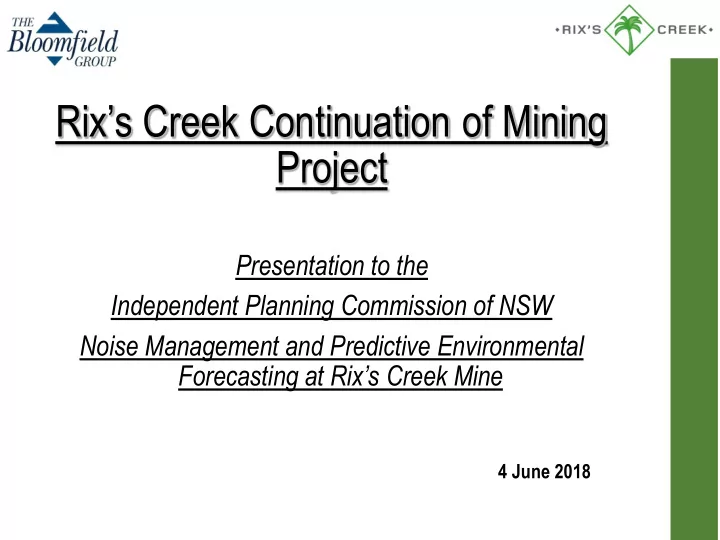

Rix’s Creek Continuation of Mining Project Presentation to the Independent Planning Commission of NSW Noise Management and Predictive Environmental Forecasting at Rix’s Creek Mine 4 June 2018
The Rix’s Creek Continuation Project Environmental Management Rix’s Creek Mine has developed a suite of predictive tools to assist in the environmental management of the mine operations. These include predictive forecasting tools for; Noise Air Quality Blast Overpressure Reinforcement Blast Plume (NOx) Air Quality Models have been developed in association with Todoroski Air Sciences, Terrock, and the Hunter Valley Meteorological Sounding Joint Venture. (Lemington SODAR). Rix’s Creek Mine employs a Noise Assessment Technician who monitors noise during evening and night time operations.
The Rix’s Creek Continuation Project Nightly Attended Noise Monitoring Rix’s Creek Mine has developed best practice noise management, utilising meteorological and atmospheric predictive modelling. This noise management system involves trained noise personnel on the ground, providing real time feedback to allow modification to mining operations where required to ensure compliance.
The Rix’s Creek Continuation Project Daily Noise Management. Predictive forecast Model completed by 6am for upcoming evening. Review of prediction by Environmental personnel- email sent to Rix’s Creek Mine Supervisors and Noise Officers detailing enhancement forecast for upcoming evening and night time period. Morning Production Meeting- discuss enhancement and operational changes if required. Note noise forecast and areas of enhancement in morning meeting.
The Rix’s Creek Continuation Project Daily Noise Management. Noise Officer reviews enhancement predictions and determines offsite monitoring locations. Noise assessment is conducted at areas showing most enhancement. Monitoring conducted- noise measurement using calibrated Rion NL 62 hand held noise meter. LAeq 15 (15 min) plus LA1, (1 min). Supervisor notified if noise is within 2dBA of limit to consider operational changes If noise is at or above limit, Supervisor instructed to shutdown machinery- feedback provided by Noise Attendant on what can be heard- dozer tracks, diff whine, train or New England Highway noise etc.
Noise Management Noise Assessment Officer records noise levels, noise details and general information (met conditions). Records of contact with Supervisor and changes to operation is also recorded. Monitoring and modification to operations in accordance with approved Noise Management Plan.
The Rix’s Creek Continuation Project Daily Predictive Modelling for Air Quality The EnvMet model is also used to provide guidance on air quality management. The model is used to determine times where operational changes are required to focus on increased dust minimisation. The Upper Hunter Air Quality Monitoring Network is also assessed to determine upstream air quality influence.
The Rix’s Creek Continuation Project Predictive Modelling used for Blasting The EnvMet model is also used to provide guidance for blasting. The model is used to determine when; meteorological enhancement may increase the risk of blast overpressure. meteorological conditions may direct blast plumes offsite toward receivers. The model is also used to predict the risk level of NOx within blast plumes leaving site and the level at which they may cause impact. These tools provide “environmentally sensible” windows where blasting will have limited effect on the surrounding community. These windows allow multiple blasts to occur with limited community impact, rather than increased risk from single blast per day restrictions.
The Rix’s Creek Continuation Project Blast Overpressure Predictive Reinforcement Model Predictive risk of blast overpressure model created by Terrock in conjunction with Todoroski Air Sciences. Forecast model is assessed daily to determine the optimum time for blasting. This model reduces the risk of overpressure reinforcement to surrounding community. Risk and area of reinforcement shown half hourly. Forecast is reviewed by blast supervisor in discussion with Environment Officers to determine optimum blast time. In this example the optimum blast time is 11:30am
The Rix’s Creek Continuation Project Predictive Plume Modelling Prediction of NO 2 level and plume direction modeled hourly. Risk rating of blast is used to determine likely fume generation risk. Length of plume related to level of NOx gas event. Forecast is reviewed by blast Supervisor in discussion with Environment Officers to determine optimum blast time.
The Rix’s Creek Continuation Project Community Complaints • No Noise complaints were identified as exceedances or non compliances. • 2018- No Noise complaints at Rix’s Creek Mine. • 2017- 29 Noise complaints- 66% from 2 residents. • 2016- 35 Noise complaints- 91% from 2 residents. • Anonymous, and DPE / EPA complaints most likely from same two complainants however cannot be confirmed.
The Rix’s Creek Continuation Project Discussion
• Rix’s Creek Continuation of Mining Project Tour - bus route
Recommend
More recommend